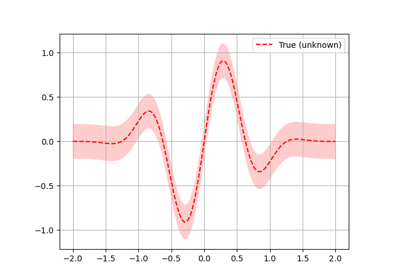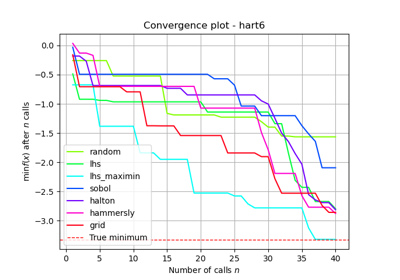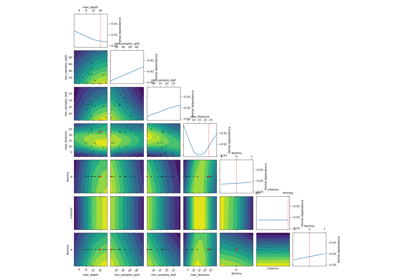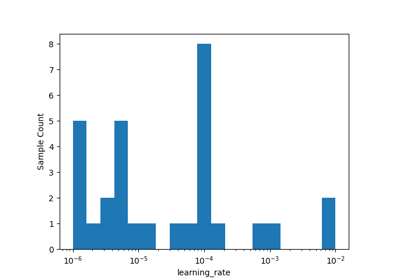skopt.gp_minimize¶
-
skopt.gp_minimize(func, dimensions, base_estimator=None, n_calls=100, n_random_starts=None, n_initial_points=10, initial_point_generator='random', acq_func='gp_hedge', acq_optimizer='auto', x0=None, y0=None, random_state=None, verbose=False, callback=None, n_points=10000, n_restarts_optimizer=5, xi=0.01, kappa=1.96, noise='gaussian', n_jobs=1, model_queue_size=None)[source][source]¶ Bayesian optimization using Gaussian Processes.
If every function evaluation is expensive, for instance when the parameters are the hyperparameters of a neural network and the function evaluation is the mean cross-validation score across ten folds, optimizing the hyperparameters by standard optimization routines would take for ever!
The idea is to approximate the function using a Gaussian process. In other words the function values are assumed to follow a multivariate gaussian. The covariance of the function values are given by a GP kernel between the parameters. Then a smart choice to choose the next parameter to evaluate can be made by the acquisition function over the Gaussian prior which is much quicker to evaluate.
The total number of evaluations,
n_calls, are performed like the following. Ifx0is provided but noty0, then the elements ofx0are first evaluated, followed byn_initial_pointsevaluations. Finally,n_calls - len(x0) - n_initial_pointsevaluations are made guided by the surrogate model. Ifx0andy0are both provided thenn_initial_pointsevaluations are first made thenn_calls - n_initial_pointssubsequent evaluations are made guided by the surrogate model.The first
n_initial_pointsare generated by theinitial_point_generator.- Parameters
- funccallable
Function to minimize. Should take a single list of parameters and return the objective value.
If you have a search-space where all dimensions have names, then you can use
skopt.utils.use_named_args()as a decorator on your objective function, in order to call it directly with the named arguments. Seeuse_named_argsfor an example.- dimensions[list, shape (n_dims,)
List of search space dimensions. Each search dimension can be defined either as
a
(lower_bound, upper_bound)tuple (forRealorIntegerdimensions),a
(lower_bound, upper_bound, "prior")tuple (forRealdimensions),as a list of categories (for
Categoricaldimensions), oran instance of a
Dimensionobject (Real,IntegerorCategorical).
Note
The upper and lower bounds are inclusive for
Integerdimensions.- base_estimatora Gaussian process estimator
The Gaussian process estimator to use for optimization. By default, a Matern kernel is used with the following hyperparameters tuned.
All the length scales of the Matern kernel.
The covariance amplitude that each element is multiplied with.
Noise that is added to the matern kernel. The noise is assumed to be iid gaussian.
- n_callsint, default: 100
Number of calls to
func.- n_random_startsint, default: None
Number of evaluations of
funcwith random points before approximating it withbase_estimator.Deprecated since version 0.8: use
n_initial_pointsinstead.- n_initial_pointsint, default: 10
Number of evaluations of
funcwith initialization points before approximating it withbase_estimator. Initial point generator can be changed by settinginitial_point_generator.- initial_point_generatorstr, InitialPointGenerator instance, default: ‘random’
Sets a initial points generator. Can be either
"random"for uniform random numbers,"sobol"for a Sobol sequence,"halton"for a Halton sequence,"hammersly"for a Hammersly sequence,"lhs"for a latin hypercube sequence,
- acq_funcstring, default:
"gp_hedge" Function to minimize over the gaussian prior. Can be either
"LCB"for lower confidence bound."EI"for negative expected improvement."PI"for negative probability of improvement."gp_hedge"Probabilistically choose one of the above three acquisition functions at every iteration. The weightage given to these gains can be set by \(\eta\) throughacq_func_kwargs.The gains
g_iare initialized to zero.At every iteration,
Each acquisition function is optimised independently to propose an candidate point
X_i.Out of all these candidate points, the next point
X_bestis chosen by \(softmax(\eta g_i)\)After fitting the surrogate model with
(X_best, y_best), the gains are updated such that \(g_i -= \mu(X_i)\)
"EIps"for negated expected improvement per second to take into account the function compute time. Then, the objective function is assumed to return two values, the first being the objective value and the second being the time taken in seconds."PIps"for negated probability of improvement per second. The return type of the objective function is assumed to be similar to that of"EIps"
- acq_optimizerstring,
"sampling"or"lbfgs", default:"lbfgs" Method to minimize the acquisition function. The fit model is updated with the optimal value obtained by optimizing
acq_funcwithacq_optimizer.The
acq_funcis computed atn_pointssampled randomly.If set to
"auto", thenacq_optimizeris configured on the basis of the space searched over. If the space is Categorical then this is set to be"sampling".If set to
"sampling", then the point among thesen_pointswhere theacq_funcis minimum is the next candidate minimum.If set to
"lbfgs", thenThe
n_restarts_optimizerno. of points which the acquisition function is least are taken as start points."lbfgs"is run for 20 iterations with these points as initial points to find local minima.The optimal of these local minima is used to update the prior.
- x0list, list of lists or
None Initial input points.
If it is a list of lists, use it as a list of input points.
If it is a list, use it as a single initial input point.
If it is
None, no initial input points are used.
- y0list, scalar or
None Evaluation of initial input points.
If it is a list, then it corresponds to evaluations of the function at each element of
x0: the i-th element ofy0corresponds to the function evaluated at the i-th element ofx0.If it is a scalar, then it corresponds to the evaluation of the function at
x0.If it is None and
x0is provided, then the function is evaluated at each element ofx0.
- random_stateint, RandomState instance, or None (default)
Set random state to something other than None for reproducible results.
- verboseboolean, default: False
Control the verbosity. It is advised to set the verbosity to True for long optimization runs.
- callbackcallable, list of callables, optional
If callable then
callback(res)is called after each call tofunc. If list of callables, then each callable in the list is called.- n_pointsint, default: 10000
Number of points to sample to determine the next “best” point. Useless if acq_optimizer is set to
"lbfgs".- n_restarts_optimizerint, default: 5
The number of restarts of the optimizer when
acq_optimizeris"lbfgs".- kappafloat, default: 1.96
Controls how much of the variance in the predicted values should be taken into account. If set to be very high, then we are favouring exploration over exploitation and vice versa. Used when the acquisition is
"LCB".- xifloat, default: 0.01
Controls how much improvement one wants over the previous best values. Used when the acquisition is either
"EI"or"PI".- noisefloat, default: “gaussian”
Use noise=”gaussian” if the objective returns noisy observations. The noise of each observation is assumed to be iid with mean zero and a fixed variance.
If the variance is known before-hand, this can be set directly to the variance of the noise.
Set this to a value close to zero (1e-10) if the function is noise-free. Setting to zero might cause stability issues.
- n_jobsint, default: 1
Number of cores to run in parallel while running the lbfgs optimizations over the acquisition function. Valid only when
acq_optimizeris set to"lbfgs". Defaults to 1 core. Ifn_jobs=-1, then number of jobs is set to number of cores.- model_queue_sizeint or None, default: None
Keeps list of models only as long as the argument given. In the case of None, the list has no capped length.
- Returns
- res
OptimizeResult, scipy object The optimization result returned as a OptimizeResult object. Important attributes are:
x[list]: location of the minimum.fun[float]: function value at the minimum.models: surrogate models used for each iteration.x_iters[list of lists]: location of function evaluation for each iteration.func_vals[array]: function value for each iteration.space[Space]: the optimization space.specs[dict]`: the call specifications.rng[RandomState instance]: State of the random state at the end of minimization.
For more details related to the OptimizeResult object, refer http://docs.scipy.org/doc/scipy/reference/generated/scipy.optimize.OptimizeResult.html
See also
functions
skopt.forest_minimize,skopt.dummy_minimize,skopt.gbrt_minimize- res








